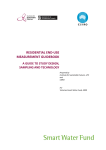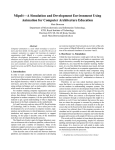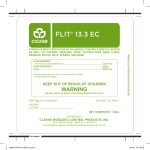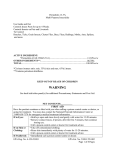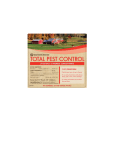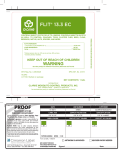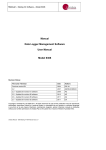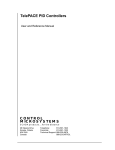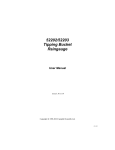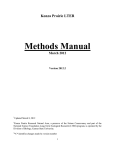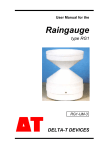Download Occupational health and safety aspects of an urban stormwater data
Transcript
Special Edition Safety in Action 25-28 February 1998 Safety Management Article 7 1999 3 VOL OCCUPATIONAL HEALTH AND SAFETY ASPECTS OF AN URBAN STORMWATER DATA ACQUISITION PROGRAM U.K. MAHEEPALA, E.R. NICHOL, A.K. TAKYI AND B.J.C. PERERA Department of Civil and Building Engineering, Victoria University of Technology PO Box 14428 MCMC, Melbourne, Victoria 8001 AUSTRALIA ABSTRACT The acquisition of urban hydrologic data involves the installation, operation and maintenance of measuring equipment in confined spaces such as underground stormwater pipes, and on roofs of buildings. This paper describes the major hazards associated with entry into underground pipes, and working on rooftops. These hazards are lack of oxygen, the presence of toxic or harmful gases and material, electrocution, and physical injury. The safety measures and equipment used to control and prevent such hazards are discussed. INTRODUCTION Hydrologic data such as rainfall and stormwater runoff are required for better understanding of the rainfall runoff process, and the development and calibration of computer models used for the design and analysis of urban stormwater drainage systems. Victoria University of Technology, in collaboration with ten local government city/shire councils in Victoria, has undertaken a major data acquisition program for 30 urban catchments. This program involves the installation, operation and maintenance of a large number of flowmeters in stormwater conveyance systems and raingauges in selected urban catchments. Many urban stormwater systems consist of a network of underground pipes, except in a few places where open channels are used. Therefore, most flowmeter installations are in confined spaces inside underground conveyance systems. The raingauges are normally installed on a roof of a building where there is no obstruction from surrounding structures or tall trees. The Australian standard for working in a confined space is followed and necessary height safety measures are taken to ensure the occupational health and safety of persons who install, operate and maintain the flowmeters in underground pipes and raingauges on buildings respectively. This paper describes the hazards associated with different stages of the project and occupational health and safety measures followed in prevention of these hazards. SELECTION OF MEASURING EQUIPMENT The main objective of the data acquisition program is to monitor the selected urban stormwater catchments for rainfall and runoff during storm events. The selection of the measuring equipment was primarily based on: • suitability and accuracy of equipment for a particular measurement; • safety during installation, operation and maintenance; • cost of equipment and support services provided by the supplier; and • ease of installation, operation and maintenance. For rainfall measurements, two types of pluviometers (ie. automatic raingauges) that are commercially available were investigated. A simple but robust type of pluviometer manufactured by Monitor Sensors, was selected. This pluviometer can be easily installed and operated, and the cost of the equipment was within the budget for the project. However, measuring the stormwater runoff is more complex than the rainfall measurements because the stormwater conveyance systems are often underground pipe systems. The human entry points to these pipe systems are the manholes usually located either on walkways or on road pavements. If the flowmeters are to be installed inside the underground pipe system, there are several hazards associated with such work in the confined space environment. In order to avoid these hazards, the option of measuring stormwater flow without entering the underground pipes (or the confined space) was first considered. Although it was possible to find some non-intrusive type flowmeters (ie. meter which did not have to be submerged) which could be installed inside the top section of a manhole without entering the pipe system, they were not selected primarily due to the following reasons. • There could be errors in flow measurements obtained at a manhole due to turbulence from change in pipe diameter, and offset of invert of pipes and manhole. • Non-intrusive flowmeters are expensive and the purchase of number of units required for the project could not be supported by the project budget. Therefore, different types of flowmeters which can be installed inside the stormwater pipes were studied and an Ultrasonic Doppler type flowmeter called ‘STARFLOW’ was selected to monitor the stormwater runoff. From a number of different flow measuring devices on the market, the STARFLOW flowmeters are the most appropriate to obtain good quality flow measurements and they are much less expensive than the non-intrusive automatic flowmeters. The goal was to achieve the optimum balance between the risks involved in the installation and operation of equipment and the cost and other factors discussed earlier, when selecting the appropriate measuring equipment. INSTALLATION OF MEASURING EQUIPMENT Installation of a pluviometer on a roof of a building is shown in Figure 1. Three holes are drilled in a concrete paving slab to match the footings of the pluviometer and this concrete slab is fixed firmly on a relatively flat roof using silicon adhesive. Then the pluviometer is fixed to the concrete slab using bolts and nuts. A diagram of the installation of a STARFLOW flowmeter in a stormwater pipe is shown in Figure 2. Flowmeter is installed on the invert of the downstream pipe. The communication cable of the flowmeter is run along the pipe and side wall of the manhole, to a box attached on the top section of the side wall. This box contains a 12V DC battery to power the flowmeter and a 9 pin socket for the computer connection. Flowmeters must be installed in a pipe at locations far enough from manholes and pipe junctions to avoid turbulent conditions that can reduce the quality of data obtained. Since such suitable locations are confined, flowmeter installation in pipes is associated with a number of hazards. Since the installation of flowmeters by drilling into concrete pipes can introduce more hazards, alternative installation methods were considered. Trials were conducted using waterproof adhesives to attach the flowmeters on to the invert of the pipes were unsuccessful because sufficient bond strength could not be achieved. Another way of installing flowmeters is to use a stainless steel band and expanding clamp arrangement. This method is particularly suitable for small pipes (ie. diameter less than 500 mm) where access is difficult and when the drilling is not possible due to base flow depths deeper than 75mm. However, the most secure way of installing flowmeters is by drilling the concrete pipe and fixing with screws, especially for large diameter pipes. Drilling has also to be done to secure the cable of the flowmeter with cable clips. 2 Figure 1: Installation of a pluviometer on a roof of a building Figure 2: Installation of a STARFLOW flowmeter in a stormwater pipe 3 Since entering the underground pipe system for installation and maintenance of flowmeters is unavoidable, all hazards that could be present in such a confined space environment should be carefully studied and appropriate preventive measures should be taken. The Australian Standard (AS 2865, 1995) for safe working in a confined space is followed as a guidance to provide for the safety of persons who enter or work inside the underground pipes. AS 2865 (1995) highlights the likely hazards associated with confined spaces and the relevant work practices necessary to deal with these hazards. EVALUATION OF HAZARDS, AND PREVENTION AND CONTROL MEASURES As indicated in De Silva (1985), hazards associated with entry into underground conveyance system can be categorised into two main groups namely, toxic hazards and mechanical hazards. Toxic hazards are generally more serious and will occur due to lack of oxygen and the presence of various harmful gases, vapours, and other toxic substances that could be found inside a stormwater pipe system. Mechanical hazards include the accidents due to inadequate guarding, and unsafe and improper use of equipment and machinery. Toxic Hazards Although the Australian stormwater conveyance systems are designed to carry only roof and land drainage resulting from storm events, there can be a number of harmful substances and toxic gases trapped inside these underground pipes. Chemical fertiliser and garden pesticides used in urban gardens, different types of detergents used for cleaning of vehicles and paving, and garden and animal waste can also be washed into the stormwater conveyance systems. Although most of these material are usually conveyed to the outlet of the system during storms, some portion could be trapped or deposited at different locations in the pipe system. Furthermore, illegal dumping of waste material and liquids from various sources is not an uncommon practice. These chemical, organic and inorganic matter present in an underground pipe system can remove oxygen by slow oxidation, especially during long dry periods. Chemical and biological reactions can produce other harmful gases such as carbon monoxide (CO), hydrogen sulphide (H2S) and combustible gases. However, a certain amount of natural ventilation may occur through stormwater entry pits. As emphasised in AS 2865 (1995), one should never trust the senses to determine if the air in a confined space is safe, because it is not possible to see or smell many toxic gases and vapours and to determine the level of oxygen present. Therefore, throughout this project, every time a person enters an underground pipe system, an electronic multi-gas monitor shown in Figure 3 is used to test the air inside the pipe system. This gas monitor gives the oxygen content, the concentration of an explosive gas, and the concentrations of CO and H2S. It also sounds a loud alarm and flashes a red warning light, if any one of the indicators mentioned before is not in the acceptable range. The gas monitor is lowered into the pipe and kept there for the entire period during which a person works inside the pipe system so that the worker can exit if the condition of air inside the system becomes unsafe. However, if any one of the indicators is close to the limit of the acceptable range, the pipe system is ventilated through manholes at both side of the work site before entering the system. Normal clean dry air consists (by volume) of 78.09% of nitrogen, 20.95% of oxygen, and 0.96% of other gases including argon and carbon dioxide (User Manual, TMX 412 Gas Monitor). Human beings can tolerate moderate variations in the amount of oxygen in the air. However, breathing becomes labored when the air contains only 16% oxygen. The gas Monitor used in this project sounds an alarm when the oxygen content in air is less than the lower limit of 19.5% by volume and higher than the upper limit of 23.5% by volume. These are the limits specified in AS 2865 (1995). The upper limit of oxygen concentration is also a very important factor to be considered because a little spark from a battery powered drill used during flowmeter installations can cause an explosion in the presence of excessive oxygen. 4 Toxic Sensor Port 1 Toxic Sensor Port 2 Oxygen Sensor Port Combustible Gas Sensor Port Toxic Sensor Display Combustible Sensor Display Oxygen Sensor Display Unmarked Keys allow alarm and calibration setting changes using removable overlay Battery Condition Display E/Backlight Key Figure 3: Gas monitor TMX 412 Battery operated electrical hammer drills and screwdrivers used in the project may also act as ignition sources and consequently cause an explosion if the combustible gas or vapour concentration is within the flammable range. This gas monitor is calibrated to give an alarm signal when the explosive gas concentration is within the lower explosive limit (LEL) of 10% and the upper explosive limit (UEL) of 20%, as specified in AS 2865 (1995). If the explosive gas content in a pipe system is found to be higher than the LEL of 10%, no person is allowed to enter the confined space until it is properly ventilated and the condition of air is improved to a safe state. Furthermore, entering any stormwater pipe is suspended, if the CO and H2S concentrations measured by the gas monitor is greater than 35 ppm and 10 ppm respectively. Since the entry to an underground pipe depends on the readings of the gas monitor, the accuracy of reading is of utmost importance. Therefore, the gas monitor is calibrated frequently using suitable calibration equipment and calibration gases, and maintained in an excellent condition to ensure the maximum safety. The supplied air respiratory equipment is not used in this project because it is not intended to enter any underground pipe in the presence of harmful or explosive gases, and when the oxygen content of the air inside pipe is outside of the safe limits. Mechanical Hazards Accidents in confined spaces can occur due to inadequate guarding against potential hazards, improper use of machinery and equipment, unsafe ladders etc., and these are very similar to the normal factory accidents. However, the main differences in a confined space environment are that the workers cannot be seen by the people outside, and also it is difficult to escape quickly in case of an accident. Unlike the exposed work places, the entry to underground confined spaces such as stormwater pipes is through a small manhole and often difficult to access. The working space is usually small. Pipes are up to 10m below the ground level and are often very dark inside, thus, the workers have to carry sufficient lighting equipment on entering the pipes. Battery operated lights and powerful torches are used in this project. A 240V powerful flash light is often directed to the manhole from outside to provide more light, especially when entering a deep manhole. As indicated earlier in this paper, entry points or manholes for underground stormwater pipes are usually located on roadside nature strips, walkways, or on road pavements. Therefore, whenever the access to a manhole is required, sufficient area around the manhole is isolated from the pedestrian usage and from the vehicular traffic, using barricades and clearly visible warning signs. All workers and stand-by persons staying at ground level are provided with reflective vests to improve the visibility of them. Manholes and pipes are inspected from above for their physical condition using a torch light. If they are in a dirty and slippery condition, the pipes are cleaned using high pressure water jets, before entering the pipe. Most of the manholes are provided with step irons for easy access to the pipes. These step irons are inspected for their condition and strength before using them because some may be rusted or damaged. 5 Extension ladders have to be used at the manholes where safe step irons are not available. Trips, slips and falls are the most common hazards that can occur during the entry to a stormwater pipe, thus, the entry is made only through a clean manhole. The area around the manhole is kept clear of loose objects, and the workers are provided with anti-slip work boots to minimise the hazard. Special attention is paid to place the ladders firmly and securely, and height safety equipment (shown in Figure 4) are used to protect workers entering deep manholes. Thus, the safety harness and tripod arrangement is used to descend and ascent a worker safely to a deep manhole without the risk of falling. Figure 4: Height safety equipment in use during a pit entry The selection of safety harness, safety line and recovery arrangement shown in Figure 4 are in accordance with AS 2626 (1983). The height safety and recovery equipment appropriate for the rescue by a direct vertical route, are used in this project. The use of these equipment is extremely important because the removal of a trapped, injured or unconscious person from a confined space can be extremely difficult without proper recovery equipment. The selection of the type of safety harness arrangement must be done carefully, as the wearing of such equipment during work can hinder free movement within a manhole or inside a pipe. Since the space available inside manholes and pipes are small, there is a great risk of hitting worker’s head against concrete surfaces and injuries to body due to rough or uneven hard surfaces and joints. Although the manhole and pipe are inspected for cleanliness before entry, there can be small amount of toxic or irritating substances present in the pipes. Therefore, the persons working inside stormwater pipes are provided with a safety helmet, suitable protective clothing, good quality gloves, and safety footwear for head, body, hand and foot protection. It should also be noted that the bulkiness and restriction of movement with head and body protection can become hazards themselves. 6 Although a powerful electric hammer drill makes the installation easier and faster, there is a great risk of electrocution due to wet conditions inside the pipes. Therefore, 240V power tools are not suitable for installations and maintenance works in the underground stormwater pipes. Expensive battery operated hammer drills and tools are used in this project to avoid the risk of electrocution. The dust and noise created by drilling inside the pipes are also hazards against which workers should be protected. There is also a risk of eye damage due to flying concrete chips. Dust masks, ear muffs and safety goggles are worn by the person when drilling is undertaken. Ear muffs are selected not only to comply with AS 1270 (1988), but also gas monitor and other emergency alarm frequencies are distinguishable when they are worn. The provision of competent stand-by person(s) at ground level is an essential and extremely important safety measure in this project. No person is allowed to enter a manhole or underground pipe without the presence of a stand-by person at site. Both persons (ie. person entering the pipes and stand-by person) are adequately informed of physical and toxic hazards associated with working inside or near the confined spaces in general, and specifically underground stormwater pipes. They have been given necessary education and training on: • recognition of hazards; • risk identification and assessment; • use of personal protective equipment; • • use of recovery equipment to retrieve an injured person from a pipe; • first aid. emergency procedures and communication; and A first aid box is always available at site, and stand-by persons are provided with a mobile telephone so that they can communicate with emergency services or any other relevant party, if the need arises. Raingauges are usually installed on a roof of a building to achieve the required clearance from obstructions and to protect them from vandalism. Hazards related to these installations are generally slips and falls when walking on roofs, and climbing up and down ladders. All necessary safety measures against slips, trips and falls, such as the careful behaviour, the use of non-slip safety footwear, and the proper placing and securing of ladders are also applied to pluviometer installations. Whenever possible, safe access to roofs through internal manholes with fixed ladders are used. Other Hazards Flowmeter installation lasts about 90 minutes. During the entire installation period a worker stays inside a pipe or a manhole, the stand-by person maintains constant visual and/or oral communication with the person inside. The stand-by person can reduce the amount of work to be done below ground by undertaking such work as cutting metal bands, drilling and fitting them to suit site conditions, and then lowering them safely to the worker inside the pipe. It is extremely hard to work in a little space such as a manhole or a pipe continuously for a long time. Therefore, if may be necessary, for persons working inside the pipes to take regular breaks, come out of the pipe, and stretch to avoid cramps and back injuries. The physical competence and aptitude of persons entering the pipes and of stand-by persons, are evaluated when employing people for these jobs. Unless the manholes and stormwater pipes are carefully inspected and cleaned, persons entering them may be at risk to insect bites from spiders, ants and centipedes. Some of the species of these insects can be very poisonous and dangerous. As the environment inside manholes and underground pipes is damp and cool, creatures like rats and snakes can also be present, especially during hot summer seasons. Therefore, careful and thorough examination of manholes and pipes before and during entry is of great importance. Non-toxic bug-killers are sometimes used in this project. However, if these substances are used, enough time is allowed for ventilation before entry. 7 OPERATION AND MAINTENANCE OF MEASURING EQUIPMENT Flowmeters and pluviometers continuously measure stormwater runoff and rainfall respectively, and store the measured data in the memory of their data loggers. These data are transferred to a lap top computer at monthly intervals. Whenever the data are downloaded from flowmeters, a person enters the pipe, and the flowmeter is checked and cleaned. Therefore, all hazards, risks and safety measures mentioned before, except those related to drilling, are also applicable to the regular operation and maintenance of equipment. All safety equipment used in the project are well maintained and kept in excellent condition to ensure that the efficiency of hazard control measures is not reduced. The safety equipment are cleaned and checked visually and stored properly after each use. If any defects or damages are found in any part of an equipment, it is repaired using genuine parts or replaced the equipment immediately. The gas monitors are calibrated frequently and gas sensors are replaced when they reach their recommended safe life time. CONCLUSIONS All hazards associated with every stage of this data acquisition program have been identified, and relevant control measures and safety procedures are followed to ensure the health and safety of workers who install, operate and maintain the measuring equipment. The Australian standards for safe working in a confined space is followed as a guidance for the safety procedures adopted in the project. The progress made so far without a single accident proves the effectiveness and the importance of the occupational health and safety procedures used in the project. REFERENCES AS 1270 (1988), ‘Australian Standard for Acoustics-Hearing Protectors’, Standards Australia. AS 2626 (1983), ‘Australian Standard for Industrial Safety Belts and Harnesses - Selection, Use and Maintenance’, Standards Australia. AS 2865 (1995), ‘Australian Standard for Safe Working in a Confined Space’, Standards Australia. Department of Primary Industries and Energy (1992), ‘Floodplain Management in Australia’, Volume 1: Executive Summary, Australian Water Resources Council, Water Management Series, No. 21, June 1992. De Silva, P.E. (1985), ‘The Hazards of Entry into Confined Spaces’, Working Together Safely, Proceedings of the 1985 Victorian Occupational Health and Safety Convention, Melbourne. Industrial Scientific Corporation, User Manual for TMX 412 Multi-Gas Monitor. Ridley, J. (1986), ‘Safety at Work’, Second Edition, Butterworths & Co (Publishers) Ltd., London. 8









